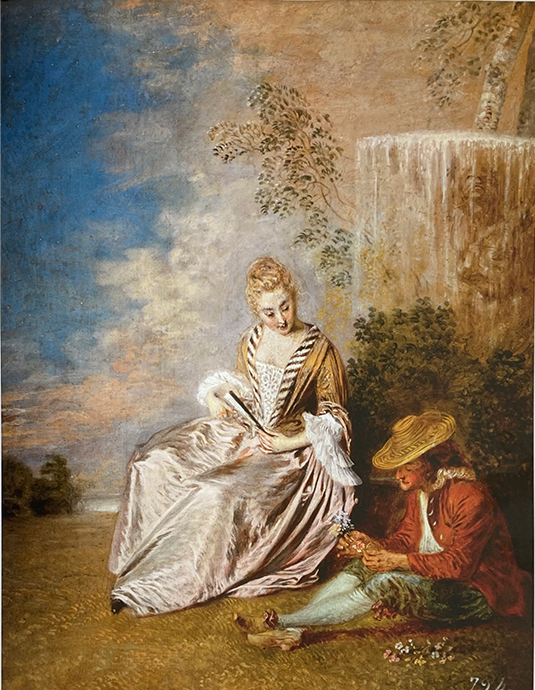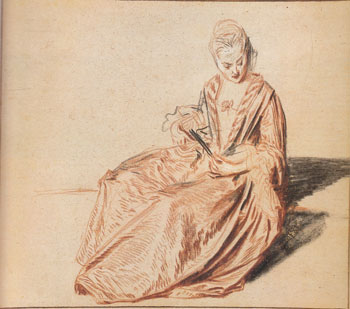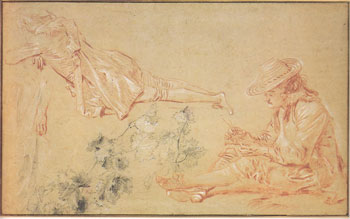
- Home Page
- Accepted
Paintings & Copies - Doubtful
Attributions - Doubtful Textual References
- Alternative
Titles - Collectors &
Museums - Bibliography
- Search Abecedario
- Watteau &
His Circle
L’Amoureux timide
Entered March 2015; revised November 2022

Madrid, Palacio Real
Oil on canvas
41 x 32 cm
ALTERNATIVE TITLES
Escena amorosa
A Love Scene
Pastorale
Le Repos champêtreScène d’amour
The Shy Lover
The Timid Lover
Young Couple Beside a Fountain
PROVENANCE
Madrid, collection of King Carlos III of Spain (1716-1788). The original French owner is not known, nor is it known when he sold this work and its pendant, La Leçon de chant, to the agent for the Spanish court. This may have transpired early on, since neither picture was recorded in the Jullienne Oeuvre gravé and, as Jullienne remarked, a good number of Watteau’s paintings had already left for Germany, England, and Spain. However, Luna thinks the pendants were purchased in Paris after a 1766 directive asked the Spanish ambassador in Paris to seek out Watteau paintings for the court. The two pictures’ early whereabouts in Spain are equally elusive. They cannot be specifically located until a 1789 inventory of art in the Madrid royal palace was drawn up by Francisco Goya, Francisco Bayeu, and Gomez.
San Lorenzo de El Escorial, Palacio de El Escorial, before 1857. L’Amoureux timide and its pendant were recorded in the museum’s 1857 catalogue. According to de Goncourt, they had previously been in a small separate building—the Casita del Principe. Nicolle wrote that they were not in that building when he visited it in 1919. He guessed that they might be in La Granja or the Palacio Real, but he could not find them.Madrid, Palacio Real.
EXHIBITIONS
Washington, Paris and Berlin, Watteau 1684-1721 (1984), cat. 44 (as by Watteau, The
Timid Lover [L’Amoureux timide], lent from the Palacio Real, Madrid).
SELECT BIBLIOGRAPHY
Poleró, Catálogo de San Lorenzo (1857), cat. 794.
Goncourt, Catalogue raisonné (1875), 182.
Calvert, The Escorial (1907), xviii.
Nicolle, “Watteau dans les musées d’Espagne” (1921), 150.
Réau, “Watteau” (1928), cat. 116.
Adhémar, Watteau (1950), cat. 176.
Mathey, Watteau, peintures réapparues (1959), 69.
Macchia and Montagni, L’opera completa di Watteau (1968), cat. 192.
Roland Michel, Watteau (1984), 270.
Grasselli, Drawings of Antoine Watteau (1987), 279.
Ferré, Watteau (1972), cat. B97.
Rosenberg, “Répétitions et répliques” (1987), 108-09.
Luna, “Watteau et l’Espagne” (1987), 280-81.
Jollet, Watteau (1994), pl. 16.
Temperini, Watteau (2002), cat. 101.
Glorieux, Watteau (2011), 238.
RELATED DRAWINGS
Watteau’s studies from models for the two figures in this painting have survived. That of the woman is now in the Getty Museum (Rosenberg and Prat 469) and that of the young man is in the Petit Palais, Paris (Rosenberg and Prat 407). Rosenberg and Prat dated these two drawings to c. 1716 and c. 1715-16, respectively. Grasselli preferred a still earlier date for the latter drawing, c. 1714-15.
REMARKS
Because the painting was not engraved in the Julienne Oeuvre gravé, occasionally critics such as Lafuente-Ferrari have rejected the composition. However, that is an exceptional stance. Almost all other modern critics accept this painting without demur.
Although scholars have agreed that this painting and its pendant are mature works, they have not been able to agree upon a specific date. Adhémar and Rosenberg preferred c. 1716, as did Glorieux. Mathey and Roland Michel suggested c. 1717-18, and Huyghe opted for a time shortly before 1720 (a date that would imply they were painted in London).
Because this painting was not included in the Jullienne Oeuvre gravé, it has been referred to by a number of different appellations. From the mid-nineteenth through the early twentieth century the painting traveled under generic titles such as Escena amorosa (as in the 1857 Escorial catalogue) or A Love Scene (Calvert’s 1907 catalogue). Edmond de Goncourt used no title at all, but, like Poleró before him, described it as “une femme assise jouant de l’éventail et regardant de côté et en dessous un gallant rustique assis à ses pieds, tourmentant d’une main timide une fleurette qu’il hésite à lui offrir.” Marcel Nicolle, who knew this and the pendant only from photographs, did not refer to the pictures by titles, only descriptions.
Goncourt’s description of the picture and the use of the adjective “timide” influenced subsequent French scholars. However, not until the 1950s did it gain the title by which it is referred to today, namely L’Amoreux timide. One can understand how this title came into being: the young man seems shy as he sits there, his face hidden from her by his brimmed hat, his whole being concentrated on a bouquet or wreath of roses. Rosenberg has proposed that this composition represents the language of flowers and harmony, with an “attentive young woman and her shy suitor,” yet the withdrawn posture of the reticent man does not suggest harmony at all. Conversely, Rosenberg interprets the pendant, with its two protagonists inclined in opposite directions, as representing the language of music and discord. But scenes of music, especially those where one character plays an instrument and the other sings, usually represent harmony; indeed, the two figures in La Leçon de chant gaze at each other’s face to foster close harmony.

